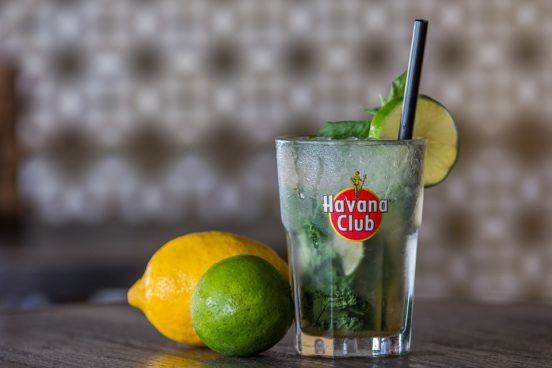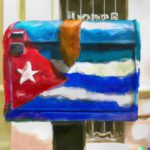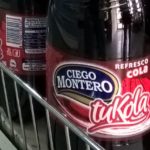Letztes Update: 5. May 2019
The Mojito – Cuba’s Cocktail Numero Uno
 The mojito is the most famous of all Cuban cocktails. Besides the classic Cuban long drink, the Cuba Libre, the mojito is the drink most tourists expect in Cuba – and drink a lot 😉 Here I use the chance to tell you something about the Mojito, especially about the preparation, so that you can indulge in your Cuba memories even in cold Europe or whereever you are – a Mojito (spoken: Mochito) in your hand, the holiday photos in front of you and Buena Vista Social Club in your ears 🙂
The mojito is the most famous of all Cuban cocktails. Besides the classic Cuban long drink, the Cuba Libre, the mojito is the drink most tourists expect in Cuba – and drink a lot 😉 Here I use the chance to tell you something about the Mojito, especially about the preparation, so that you can indulge in your Cuba memories even in cold Europe or whereever you are – a Mojito (spoken: Mochito) in your hand, the holiday photos in front of you and Buena Vista Social Club in your ears 🙂
 The Recipe
The Recipe
 If you don’t want to prepare the Mojito according to your intuition, I’ve dug out the following recipe:
If you don’t want to prepare the Mojito according to your intuition, I’ve dug out the following recipe:
Condiments
- 50 mls 3-year-old rum
- 90 mls mineral water
- 3 tsp white cane sugar or 20 mls sugar syrup
- 1/2 lime or 25 mls lime juice
- 2 sprigs of fresh mint, that’s 6-8 leaves of mint
- crushed ice
- 3 splashes of Angostura
- 1 Mint branch as decoration
Description of ingredients
 Rum: Typically the 3-year-old, nearly white rum is used. According to the story, however, Sir Francis Drake used fresh white rum (Aguardiente). But Aguardiente is too hard for us – it’s more like Schnapps – that’s why we stick with the three-year-old.
Rum: Typically the 3-year-old, nearly white rum is used. According to the story, however, Sir Francis Drake used fresh white rum (Aguardiente). But Aguardiente is too hard for us – it’s more like Schnapps – that’s why we stick with the three-year-old.- Mineral water: soda water should actually be used, i.e. a mineral water with a high sodium content. Only the sparkle doesn’t turn mineral water into soda water! Brands available in Germany include Fachingen, Karlsbad, Marienbad, Niederselters and Vichy. For the ones you can use in your country, you will have to do a web research.
- White cane sugar: in Cuba, highly refined cane sugar is commonly used, which has a weaker taste than brown cane sugar. When in doubt, it is better to use white beet sugar than brown cane sugar, because it’s closer to the original.
- Lime: The lime is not to be confused lemon. You need the table tennis ball sized, green fruits, not the big yellow ones.
In Cuban bars, pre-pressed juice from a plastic bottle is usually used due to the faster preparation time. That does not damage the drink, but often the cocktail mixer takes a biiiig shot of lemon out of the bottle and the mojito can get too sour.
- Yerba or Hierba Buena: Cuba has a special peppermint, the Hierba Buena, Menta Nemorosa or Hemingway mint, a special mint plant that is different from ours outside of the Caribbean – it does not taste like chewing gum – like spearmint or other mint and has a lighter, more fruity aroma. Here, Hierba Buena is of course not easy to get, but it also grows in Spain for, example. If you don’t want to do without the original mint taste, you don’t have to import plants or seeds from Cuba (it’s illegal, by the way), but you can also buy them in garden centres. During a short search I found the Dehner garden centre in Germany, for example, which sends the original Cuban mint plants directly as “Mojito Mint”. A funny fact from the Dehner-Garten centre website, about the planting out of the Mojito Mint: “However, you must bear in mind that it may be spreading rapidly.” So be prepared: once you plant it out, you may have to drink mojitos until the plant is reduced again and the garden is free of it 😉
- The ice: The ice should be coarsely crushed, so it mixes with the drink just enough. Crush the ice cubes in a special ice crusher. If you don’t have a crusher, use a freezer bag, fill in the ice and hit the wrapped ice with the round side of a tablespoon. Works like a miracle (Thanks to my Cuban father-in-law, who knows such tricks – he was a sailor and an engineer!). Never use ice snow (or how that fine white snowy ice is called), it will melt away in no time and dilute the drink!
- Angostura: Angostura Bitter is a herbal-alcohol mixture from Venezuela, used to counter the sweetness of the mojito. Gives the drink a slightly reddish-brown colour.
- Decoration: 1 large mint branch is an excellent decoration for your mojito. Can also be eaten, tastes nice of mint – learned that one from one of my professors 😉
Preparation
 Pour the mint leaves, lime juice and white sugar into a large cocktail glass. Stir vigorously – the sugar rubs against the mint leaves so that they release their aroma. Let it soak a little. Optionally, and especially if you want to serve immediately, you can also press the leaves slightly against the glass edge with a Muddle Stick. But never crush the leaves, it will bring out the bitter substances!! Same with the lime: we only take the juice and not the whole fruit!!!
Pour the mint leaves, lime juice and white sugar into a large cocktail glass. Stir vigorously – the sugar rubs against the mint leaves so that they release their aroma. Let it soak a little. Optionally, and especially if you want to serve immediately, you can also press the leaves slightly against the glass edge with a Muddle Stick. But never crush the leaves, it will bring out the bitter substances!! Same with the lime: we only take the juice and not the whole fruit!!!
Some people also fill in brown sugar with pieces of lime and mint into the glass and then squeeze it. But we don want a mint salad or, even worse, a Caipirinha, but a Mojito – Cuban not Brazilian!!
Now fill the glass with the crushed ice until the glass is full. Then pour the rum, according to taste… 😉 Mix with the spoon to spread the sugar and mint: close your hand around the glass opening so that the ice cubes do not fall out. Quickly add a few splashes of angostura, which we do not mix, the mint twig as decoration in the drink and ready. If you want, you can clap the mint branch before planting, then it spreads a pleasant mint aroma.
Variants
 If you want to, try other mojitos, we recommend the Havana Club website, where you can get the recipe for a raspberry mojito 🙂
If you want to, try other mojitos, we recommend the Havana Club website, where you can get the recipe for a raspberry mojito 🙂
Fun Facts about Cuba and the Mojito
Hemingway
 Ernest Hemingway is probably the most famous mojito drinker. “My mojito in the Bodegita del Medio, my daiquiri in the Floridita,“ it says, written by Hemingway himself, on a framed napkin in the Bodegita. In the Bodegita del Medio he was a regular guest, drank the sweet mojito and in the Floridita his typical unsweetened Daiquiri.
Ernest Hemingway is probably the most famous mojito drinker. “My mojito in the Bodegita del Medio, my daiquiri in the Floridita,“ it says, written by Hemingway himself, on a framed napkin in the Bodegita. In the Bodegita del Medio he was a regular guest, drank the sweet mojito and in the Floridita his typical unsweetened Daiquiri.
There is a discussion if he really drank Mojito at all and if this writing is only fake, but because of certain clues I am in favour of Heminway being really a Mojito drinker.
Nowadays the fame of both bars – Bodegita and Floridita – is based on Hemingway, obviously, and not on the quality of their drinks and they are magnest for tourists. You should take this into account when you go to the Bodegita – you can’t expect quality there, nor can you expect good prices.
And by saying this, let’s go through the prices:
How much can a mojito cost in Cuba?
The price for a Mojito in Cuba is not necessarily cheap, especially in tourist regions such as the old town of Havana (Habana Vieja). The Mojito can cost 4 to 6 CUC without having being especially good. But if you look, you’ll find the same mojito quality one corner away for 2 to 3 CUC. Only rarely do you get a mojito for one euro nowadays, these are either student drinks without any aspiration (e.g. in Casa de los Baleares) or they are served with food like in La Catedral. But those are really the exception.
Good quality Mojitos are a rare breed in Cuba
 A word on the quality of the Mojito in Cuba in general: not only suffered the cuisine under socialism, but also the quality of the cocktails. So if you have a recommendation for a really good mojito, where the bartender takes time and really knows something about cocktails – I am always open for recommendations. My experience is this: you always get some mojito, quality stands for the amount of rum. But a mojito at hotel bar level has rarely been accommodated.
A word on the quality of the Mojito in Cuba in general: not only suffered the cuisine under socialism, but also the quality of the cocktails. So if you have a recommendation for a really good mojito, where the bartender takes time and really knows something about cocktails – I am always open for recommendations. My experience is this: you always get some mojito, quality stands for the amount of rum. But a mojito at hotel bar level has rarely been accommodated.
Mojito Variations
Mojito Frapé
A new wave of Mojito variations is spreading in Havana, the Mojito Frapé! This is a mojito with much ice cubes that is poured into a blender and mixed until we have a fine-grained ice cream mixture. What I don’t know exactly is whether it’s more ice than in a normal Mojito or just ice cubes instead of ice crush. If you try mixing the Mojito Frapé yourself, let me know how you do it!
Mojito variations with fruit
The Mojitos in the in-bars are also now flavoured with fruit. Sometimes the fruits are an additional ingredient (pineapple, melon…) like in the “Mojito, Mojito“, or the bar keeper replace the mint with fruit, like in “El Del Frente“. There, the fruits are crushed to free their taste. By the way, cut-off rum bottles are the new fashionable glasses. So don’t be surprised if the mojitos are a bit more expensive, they simply have more content 😉
Mojito ToGo – walk around with your Mojito
My personal insider tip is the Mojitos ToGo in “La Chucheria” further down the Malecón, right next to the Galerías de Paseo. There you get a good Mojito in a practical ToGo-variation for 3 or 3,50 CUC, can’t remember exactly… 😉 In any case, with the Mojito ToGo you are the star on the Malecón, the others will envy you 😀
I’ll drink to your health,
Salud! says Dietmar, unfortunately only from Germany at the moment…
PS: What you have to consider carrying Rum with the airplane, you can read here!









